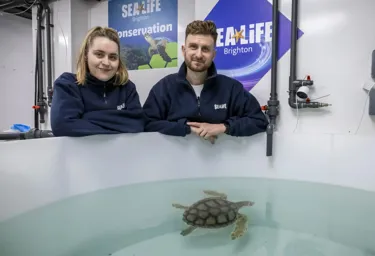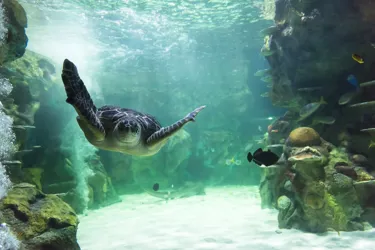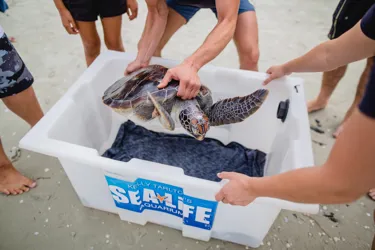Turtle Rehab and Release
- Monday 18th August 2025
- Conservation, Turtle

In an exciting leap forward for marine conservation, SEA LIFE Brighton is now home to the UK’s first dedicated sea turtle rehabilitation centre. Opened in 2024, this pioneering facility is designed to care for injured or stranded sea turtles found in UK waters something that, until recently, was almost impossible without sending animals abroad. This marks a major milestone for marine rescue in the UK, putting Brighton on the map as a leader in animal care and ocean preservation.

The centre, built within SEA LIFE Brighton’s Victorian arcade, is tailored specifically for turtle triage, care, and rehabilitation. At its core is a bespoke tank system that mimics natural ocean conditions while allowing expert animal care teams to monitor and treat the turtles’ progress. Most of the turtles arriving at the centre suffer from “cold-stunning” a life threatening condition caused by sudden drops in water temperature. These turtles, often found along the UK’s southern coastline, would previously have faced uncertain futures. Now, thanks to Brighton’s facility, they receive immediate care, nutritional support, and recovery programs, all in one place.
This initiative is a direct response to a growing need. In 2024 alone, SEA LIFE rescued 171 turtles globally, including critically endangered species like the Hawksbill and endangered Green Sea Turtle. The cold waters of the UK may seem an unlikely home for sea turtles, but these animals are powerful ocean voyagers, often carried by warm currents from the Caribbean or West Africa before being stunned by Britain’s colder tides. The Brighton rehab centre closes a crucial gap in the UK’s marine conservation landscape, ensuring that distressed turtles get the local, specialised care they need.

Beyond treatment, the centre is designed to inspire. Visitors to SEA LIFE Brighton can observe the rehabilitation process and learn firsthand about the threats turtles face entanglement in plastic, habitat destruction, and rising ocean temperatures among them. Through interactive education and storytelling, the centre empowers the public to play their part in protecting marine life. This education first approach aligns with SEA LIFE’s global commitment to conservation, which in 2024 included delivering over 55,000 educational talks and engaging with more than 650,000 students worldwide.
Globally, sea turtle populations remain under pressure. According to the IUCN, six of the world’s seven species of sea turtles are considered vulnerable, endangered, or critically endangered. Factors such as plastic pollution, illegal wildlife trade, and climate change continue to threaten their survival. SEA LIFE’s broader conservation strategy spanning four continents includes turtle tagging in Florida, rescue support in New Zealand, and coastal cleanups that remove tonnes of waste from habitats each year. The Brighton centre complements these efforts by offering a UK based solution to a global problem.

The launch of the turtle rehab centre is not just a win for conservation it’s a call to action. With climate change reshaping our oceans, animals like sea turtles are more vulnerable than ever. SEA LIFE Brighton is leading by example, showing how innovative facilities, expert care, and public education can come together to protect our planet’s most iconic marine travellers. It’s a powerful reminder that even one centre built within a centuries old arcade can have a lasting impact on the future of our seas.
Turtle Rehab & Release FAQ's
1. How many turtles does SEA LIFE rescue and rehabilitate each year?
In 2024, SEA LIFE rescued 171 sea turtles globally. Over the last five years, they’ve released 100 sea turtles back into the wild
2. Where are turtle rehabilitation centres located?
Dedicated centres operate in Brighton (UK), Sydney (Australia), Texas, Sunshine Coast (Australia), and Kelly Tarlton’s (NZ)
3. What happens to turtles that can't be released?
Non-releasable turtles due to injury or condition remain in lifelong care at SEA LIFE aquariums, serving as ambassadors for education and conservation
4. How are turtles monitored after release?
Many released turtles receive satellite tags so scientists can track their migration, nesting, and feeding behaviours
5. Can the public see or interact with rehab turtles?
Yes. For example, SEA LIFE Grapevine (Texas) has a live rescue and rehab exhibit, where visitors can observe and learn about ongoing turtle care
6. What turtle species are involved in these programs?
SEA LIFE works with all seven species of sea turtle (green, hawksbill, loggerhead, olive ridley, Kemp’s ridley, leatherback, flatback), plus freshwater turtles like European pond turtles and terrapins
7. Why are sea turtles endangered and what are the main threats?
Major threats include fishing net entanglement, plastic ingestion, boat strikes, egg poaching, habitat loss, and climate change (warmer sand biases hatchling gender). SEA LIFE’s efforts aim to combat all these challenges